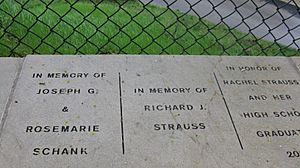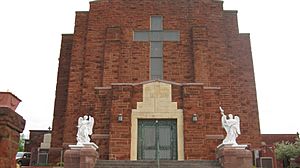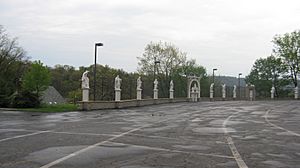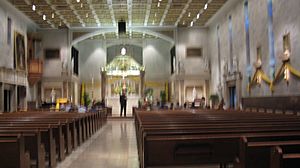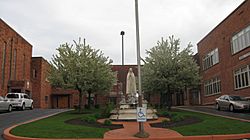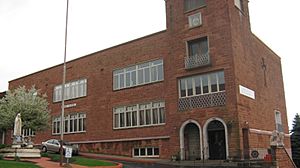Mount St. Peter Church facts for kids
Quick facts for kids |
|
|
Mount Saint Peter Catholic Church
|
|
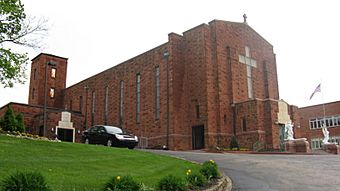 |
|
| Location | 100 Freeport Road, New Kensington, Pennsylvania |
|---|---|
| Area | 3.1 acres (1.3 ha) |
| Built | 1942 |
| Architect | Enos Cooke |
| Architectural style | Art Deco, International style |
| MPS | Aluminum Industry Resources of Southwestern Pennsylvania MPS |
| NRHP reference No. | 98000398 |
| Added to NRHP | May 5, 1998 |
Mount Saint Peter Church is a Catholic church located at 100 Freeport Road in New Kensington, Pennsylvania. It sits near the Allegheny River, about 25 miles (40 km) northeast of Pittsburgh. The church is part of the Diocese of Greensburg.
The church was started by Italian immigrants in the early 1900s. The building you see today was built by hand by church members during World War II. They used materials from a large mansion in Pittsburgh that was being taken down. The church was officially opened on July 4, 1944. In 1998, it was added to the National Register of Historic Places, which lists important historical sites.
As of 2009, about 5,000 people were members of the church. Mount Saint Peter is well-known in the area for its yearly Festa Italiana. This festival features homemade Italian food, dancing, games for kids, and fun for adults. Church volunteers organize the festival, which happens on the church grounds during the first weekend of August. The church's main goal highlights its strong Italian background.
Contents
The Church's Story
The story of Mount St. Peter Church is closely linked to the history of Alcoa and how New Kensington grew into an industrial city in the early 1900s. In 1890, a company called Burrell Improvement Company saw the flat land south of Lower Burrell as a good place to build. They named the area New Kensington and planned out its streets.
The Pittsburgh Reduction Company (which later became Alcoa) was the first big company to buy land by the river. Other businesses also set up factories and shops. The presence of these companies brought many jobs and helped the city grow. By 1910, New Kensington even had car manufacturing companies.
Diocese of Greensburg's Beginnings
Mount Saint Peter Church belongs to the Diocese of Greensburg. A diocese is an area managed by a bishop in the Catholic Church. This diocese was created on March 10, 1951, by Pope Pius XII. Records show that the first Catholic Mass in this region was held in 1749 by a French priest.
After the American Civil War, more Catholic immigrants from Eastern Europe moved to areas like Armstrong, Fayette, Indiana, and Westmoreland counties. They came to work in coal mines and steel mills. This led to the creation of over 80 new churches and missions between 1865 and 1917.
Starting St. Peter Parish
By 1900, New Kensington had grown to 4,600 residents. In 1902, Reverend Bonaventure Piscopo started a new church in New Kensington. It was meant for the many Italian Catholics who had moved there for work. The church was named after Saint Peter, who Catholics believe was the first pope.
These Italian immigrants lived in New Kensington, Arnold, and Parnassus. They needed a place to worship. In 1903, the St. Peter congregation began holding Mass with a resident pastor, Reverend Vincenzo Maselli. They met in a small building in downtown New Kensington.
Soon after, in September 1903, the group moved to the basement of St. Mary's Polish Church. The first church records were made there. On July 4, 1905, the first stone of the new St. Peter Church was laid. Bishop Regis Canevin officially opened the new church on September 25, 1905.
Around 1908, fewer people attended St. Peter Church. Many priests had been moved to other churches. The priests who stayed tried their best to keep the church going. Most of them had studied in Italy and did not speak English very well. At that time, immigrants wanted to fit into American life. So, some Italian Catholics stopped going to Italian churches or even changed their religion. Priests were also paid very little and often had no permanent homes. They sometimes traveled long distances to say Mass at several churches in one day.
Challenges for the Italian Community
Around 1918, some groups who disagreed with the church caused problems for the members and priests. This made it difficult for people to attend Mass. At St. Peter's, one priest was harmed while working. Another priest was threatened. By 1918, only thirteen families attended Mass on Sundays. This continued for several years until 1925.
By 1929, St. Peter Church was very crowded for all three Sunday Masses. So many people came that the balcony and other areas were opened for seating. Hundreds of people even stood outside on the steps to hear Mass. Still, many people could not get in. About a thousand families belonged to St. Peter parish, but the church only had about two hundred seats. In 1933, Bishop Hugh Boyle suggested building a larger church. The congregation decided to build a bigger one.
Church members started building the new church in May 1941. Three years later, the new building was officially opened.
World War II's Impact
By May 1944, church members had greatly helped the war effort. They donated thousands of pints of blood and money to war relief. They were also active at home and sent 808 men and women to the Armed Forces. A group sent a weekly newsletter to members serving in the military. These members were happy to hear about the new church's progress and sent money for its construction.
Seven of the 808 members who went to war died. Their names are carved on a granite piece outside the church.
Building a New Church by Hand
The old church building was too small, and the congregation needed a larger one. People from different towns wanted the new church built closer to them. Finally, a location was found on Freeport Road and Seventh Street in New Kensington. This spot was about 100 yards (91 m) from the old church and sat on top of a hill. The land was 4 acres (1.6 ha) and had a large mansion and other small buildings.
The land once belonged to Stephen M. Young, a General in the United States Army during the American Civil War. The church bought the property for $20,000 in 1938. On December 1, 1938, the congregation made a down payment. A few days later, the Building Fund Campaign started with 100 volunteers. Each full-time working member was asked to pledge $60 over five years for the church's construction. Volunteers went door-to-door almost every day for five years to collect enough money.
On April 1, 1939, St. Peter's congregation took ownership of the land and mansion. That day, they decided the new church would be called "Mount St. Peter." By May 1, they had raised $23,500 in cash and pledged another $75,200.
Getting Materials from the Mellon Mansion
Architect Enos Cooke designed the new church. In 1940, a friend of the church, John Stanish, told the congregation that the Mellon mansion in Pittsburgh was going to be torn down. This mansion was huge, with 65 rooms and many expensive features. It had marble from all over the world, bronze doors, and hand-painted ceilings. Many valuable items were being sold for very low prices.
The church realized that many items from the mansion could be used in their new building. For example, mantles could become altars, and angel statues could be placed in the church. In 1940, St. Peter's congregation bought all the stone, granite, marble, bronze doors, railings, 30 tons of steel beams, 65 oak doors, chandeliers, and other items from the mansion. Church members then transported all the marble 27 miles (43 km) from Pittsburgh to New Kensington. The Mellon mansion's location is now Mellon Park.
Many men from the church volunteered to move the materials. A contractor, Mr. Charles Camarata, directed this free labor. He divided the volunteers into three groups. One group removed the marble from the mansion, another transported it, and the third placed the materials at Mount St. Peter. This project lasted from December 1940 to May 1941. It was hard work, especially during the tough winter of 1940–1941.
Building Mount St. Peter Church
On Sunday, May 25, 1941, construction officially began for Mount St. Peter Church. About two thousand people came to watch the event. The cornerstone was blessed on Sunday, September 7, 1941. Many priests were there, and the ceremony included sermons in both English and Italian. The large red granite cornerstone held a metal box with church reports, newspapers, coins, and medals. It can be seen inside the church near the altar of the Sacred Heart.
Raising Money for Construction
At this time, only about $15,000 was left from the building fund. More money was needed for construction. The church started another fundraising effort and received 1,200 pledges. Most of these pledges were fulfilled. Ladies from the St. Peter's Cenacle (a church group) kept all the financial records. They recorded pledges, collections, and meeting notes.
Dom C. Shiarella, the treasurer of the First National Bank in New Kensington, oversaw the Building Fund Campaign. He collected all the pledges and made sure there was enough money for payroll every two weeks. He worked extra hours almost every evening for five years.
By October 1941, funds were low again. The parish sold a house it owned for $7,000. This money helped pay off debt and cover ongoing construction costs.
Finishing the Roof
Winter was approaching, and the roof needed to be built quickly to protect the church walls from damage. This meant more workers were needed, but the church didn't have enough money to hire them. Thirty church members, who had already given a lot, each lent another $500. This gave the church an extra $15,000 for the roof. For about two months, over fifty church members worked daily on the roof. It was finished in December 1941.
One worker, James DiMuzio, left to join the United States Air Force after hearing about the attack on Pearl Harbor. He was the first church member to die in the war. A plaque with his name is on a pier outside the church.
The winter of 1941–1942 was mild, allowing work to continue until January 27, 1942. John Stanish became the assistant director. He built special machines for working with marble and used heavy equipment like bulldozers. He also collected materials like marble, iron, and electrical equipment from different states. An inscription in Latin, Joannes Stanish Res Procuravit (John Stanish procured the material), was placed in the church's main entrance to thank him.
Many volunteers helped with the inside of the church, working under skilled plumbers, electricians, and craftsmen. A group of women also polished the marble and granite until it shined. The dome over the altar was built by Alex Guadagno, an Italian immigrant who owned Gains Ornamental Iron Works.
Opening of Mount St. Peter Church
By mid-1942, Mount St. Peter Parish needed more money. Most of the new church was done, so the congregation decided to sell the old St. Peter Church. The General Electric Company bought it for $16,000 on July 16, 1942.
Sunday, August 9, 1942, was an emotional day. The last Mass was held in the old St. Peter Church, which had been their home for 38 years. People cried as the Blessed Sacrament was carried out. The congregation then followed the pastor to the new church.
Mount Saint Peter Church looked grand on the hill. It felt much richer than the old church. But because so many members had worked hard and shown their love and faith, they were proud to call it their own. Building the church had some dangers. Once, a large crane bucket fell near some teenage boys, destroying their tools, but no one was hurt. A heavy bronze door fell on a worker, but he was unharmed. Another time, an 18-year-old fell from the church tower but managed to grab a pulley and was saved.
Even though many years have passed and most of those who helped build it are gone, Mount St. Peter Church still stands. It is a Catholic church at 100 Freeport Road in New Kensington, Pennsylvania. It is located along the Allegheny River and is part of the Diocese of Greensburg. The church was founded by Italian immigrants, and its current building was built by its members. In 1998, it was added to the National Register of Historic Places.
Church Additions
The Marble Hall
The Marble Hall is the basement of Mount St. Peter's. It measures 125 by 55 feet (38 by 17 m). Before the church was finished, this area stored valuable materials from the Mellon Mansion. By winter 1944, the basement was empty. Nicholas Givens donated a lot of marble for the basement. Workers covered the floor with black asphalt tile and the walls and pillars with white Carrara marble. They also built two marble altars and a large kitchen that could feed up to 400 people.
While the Marble Hall was being built (1944 to 1948), Father George Goralka, an assistant pastor, added an inscription around the ceiling. It quotes Christ's words to Peter from the Bible. The basement was named the Marble Hall after it was finished, and the name stuck. Today, the Marble Hall is used for special meals, fundraisers, and as the Italian Restaurant during the Festa Italiana in August. On busy holidays like Christmas and Easter, Mass is held both upstairs and downstairs in the Marble Hall.
The Rectory
A rectory is a house where the church's pastor lives. Before 1944, the priests and their housekeeper lived in an old mansion on the property. It was over a hundred years old and not in good condition. So, the church needed a new rectory.
Construction for the new rectory began in 1944. An engineer, Frank H. Recco, advised the project. Church members borrowed a bulldozer and a steam shovel to dig the foundation for a two-level building. They bought cinder blocks for eight cents each. Young men from the church made Flexicore slabs for the floors and roof. John Stanish gathered free flexicore forms, cement, and bricks from abandoned sites.
The three-story rectory took three years to build. The first floor has a dining room, kitchen, pantry, laundry room, and a three-car garage. The second floor has offices, a community room, a large library, and a spacious veranda. A large stained glass window from Germany, repurposed from the Mellon Mansion, is in the hallway. The third floor has ten rooms divided into four apartments and two guestrooms, plus an open veranda.
The rectory also has nine bathrooms and one elevator, all taken from the Mellon Mansion. Two fireplaces from the mansion were also used. One, carved from lava of Mount Vesuvius, is in the community room. The other, made of red Michigan sandstone, is in the dining room.
The Mount Saint Peter Oval
After the church and rectory were finished, workers planned a plaza. The old mansion on the property was torn down to make space for it. A 10-foot (3 m) wide road was built around the area that would become the oval. John Stanish decided to pave the oval with small pieces of marble left over from the church building. These pieces were of different types, colors, and sizes. John Martorana arranged them artistically.
In 1947, a granite pedestal from the Mellon Mansion was placed at the north end of the oval. On top of it, a life-size bronze statue of Christ with open arms was placed. On Armistice Day, November 11, 1951, the monument was dedicated to the defenders of the United States.
Alcoa donated a tall flagpole to the oval. The American flag was raised for the first time by Joseph Iozzi, a disabled World War II veteran. Many community groups attended the dedication. A priest from Italy, Monsignor Giustino Meniconzi, blessed the statue of Christ and the American flag.
Convent School
The next building project was an eight-foot arch connecting the rectory to a future building. A statue of Saint Peter was placed above the arch. A large stairway goes down from the arch to the lower part of the grounds.
For two years (1948 to 1950), work was done on the new three-story building connected to the rectory. It was made of flexicore slabs. The outside used a mix of new and old bricks in the back and red Michigan sandstone in the front, matching the other buildings. The inside was plastered for free by Dom Graziano, a skilled plasterer whose father was a church member.
When finished, the building had two classrooms, a kitchen, a laundry room, a pantry, and a main entrance on the first floor. The second floor had three classrooms and a chapel. The third floor was a living area for the teaching sisters, with eight rooms, a kitchen, a dining room, and a community room. This building served as a permanent convent and a temporary school.
Parochial School
Since the convent school was temporary, the next step was to build the actual school. The parochial school took ten years to build (1950–1960). This building also has three floors. The front is covered with red sandstone, and the back with white Pennsylvania sandstone. It has a bell tower with three heavy bronze bells salvaged from old Protestant churches in Pittsburgh.
The school's walls are faced with blue tiles from Kittanning. Mr. Clifford McNees, president of the Kittanning Tile and Brick Company, sold the tiles at a much lower price to help the church. Luigi Valle, a church member, advised workers on how to set the tiles for many days without pay. After he passed away, Bruno Regoli and his two sons, Bruno Jr. and John, finished the tile work. John later became a priest at Mount St. Peter Parish.
Two large granite lions from the Mellon Mansion gardens stand at the school's main entrance. Above the door is a terracotta Madonna statue by Della Robbia. Inside the school, there are nine classrooms, two auditoriums, a library, a cafeteria, and a utility kitchen. When the school opened in 1960, it taught children in grades 1–8. Later, a kindergarten and preschool were added.
In September 2002, Mount Saint Peter School joined with Saint Joseph and Saint Margaret Mary Schools to form Mary Queen of Apostles School. Now, the school at Mount St. Peter's teaches children from preschool through third grade.
Pastors of Mount St. Peter
| Appointment | Name |
|---|---|
| 1902 | Fr. Bonaventure Piscopo |
| 1903 | Fr Vincenzo Masselli |
| 1903 | Fr. Joseph DiSabato |
| 1905 – 1906 | Fr. Charles Galassi |
| 1907 | Father F. Pozukanis Father L. Pastorius |
| 1914 | Father Fortunato Sacchi |
| 1915 | Father James Vocca |
| 1923 | Monsignor Nicola Fusco |
| 1968 | Father Francis L. Ginocchi |
| 1983 | Father Leonard T. Sanesi |
| 1992 | Father Richard G. Curci |
| 2005 | Monsignor Michael Begolly |
The pastor of Mount St. Peter Parish is chosen by the Bishop. The pastor is the leader of the church. When a pastor leaves, another is appointed. The pastor makes sure everything runs smoothly with the priests and church staff. They work with church councils to understand the community's needs and help build God's Kingdom among the members.
Mount St. Peter Today
As of 2009, the church had about 5,209 members. The church's motto, adopted in 2004, is: "to restore all things in Christ...with the fire of love."
Mass is held every weekday morning at 8:30 am. On Saturday evenings, Mass is at 4:00 pm. Sunday Masses are held weekly at 8:30 am and 10:30 am.
Festa Italiana
As part of its ongoing mission, the church hosts an annual Festa Italiana every August. The festival has many activities, but the food is a main attraction. The menu often includes lasagna with homemade noodles, spaghetti and meatballs, hot sausage sandwiches, pasta e fagiole, Italian rice balls, and other dishes like pulled pork and baked chicken. Desserts include cannoli, frappe, pizelles, biscotti, and gelato. One church member said, "I like seeing everyone from town, but the food is always an attraction."
Church Groups
Here are some of the groups that are active at Mount St. Peter Church today.
Addolorata Society
Members of this society attend funeral Masses and collect money to buy altar linens, vestments, and altar lights.
Saint Anthony Guild
In 1939, Mrs. Angela Costanza Bongiovanni and Monsignor Fusco started the Saint Anthony Guild. Thirty-two women joined this new group. Their goal was to help the parish and support the poor and needy in the area. They also volunteered at the St. Anthony Orphanage, which is why they chose the name. All members are women, and they aim to find friendship and spiritual renewal by helping the church and community.
As of 2010, the group has 47 active members. They meet on the third Tuesday of February, April, May, August, September, October, and November in the Marble Hall. They discuss projects and pray together. The St. Anthony Guild is known for visiting home-bound members during Christmas and Easter. They also have a "Tree of Angels Campaign" where people can buy angel ornaments in memory of loved ones. The money raised helps children in need. The guild also holds fun fundraisers like dances, bingo nights, and selling coupons for shopping days.
Altar Servers
Altar servers wear long, white robes and help the priest during Mass. At Mount St. Peter Church, four altar servers assist at every Mass. One carries the Bible for the priest. Another carries a large wooden crucifix and leads the procession when the priest enters and leaves the church. The other two servers light and extinguish the candles.
Confraternity of Christian Doctrine
Members of this group teach in the parish's Sunday Schools. Mount St. Peter's has seven different Sunday Schools. Most children who attend are between 6 and 12 years old.
Holy Name Society
Members of this society host a Mass and breakfast on the Sunday before Palm Sunday each year. They also have an annual Golf Outing in the summer. The money raised from these events is given to the church to help with parish projects.
Ushers' Club
The Ushers' Club has 30 or fewer men from the church. They are chosen by the church leaders. Their job is to help people find seats during Mass, guide members for communion, and collect offerings. Members also volunteer their time and help at church social events.
St. Vincent De Paul Society
Mount St. Peter Parish has a local branch of the Saint Vincent De Paul Society. This group's goal is to help the poor, the sick, and those in need. Members collect food and deliver it to food banks in and around New Kensington to help people locally.
Mount Saint Peter Parish Council
The Mount Saint Peter Parish Council was first elected in March 1972. This group has eighteen elected members. They advise and help the pastor with important church decisions. The council's main purpose is to share the parish community's thoughts and feelings on different issues with the pastor. All church activities go through four main committees: Liturgy, Education, Apostolic Work, and Temporalities.




